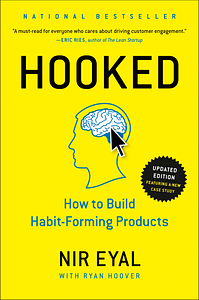Take a photo of a barcode or cover
Very fast read. Eyal opens this book with an emphasis on addictive product development - that put me on edge and caused me to read the rest of the book more critically and with a grain of salt.
After that brief intro, Hooked jumps right into the model/cycle of habit-forming products:
1. Trigger
2. Action
3. Variable Reward
4. Investment
Although not every product or feature should use this cycle, it's a solid model to apply in many cases. Something I should look for in my work - and a pattern I see in OneDrive and other products.
That said, there was little new content for me in this book. There's merit to its simplicity, but I was looking for more meat.
Even with my "low" rating, I'd recommend this to anyone working in product development.
After that brief intro, Hooked jumps right into the model/cycle of habit-forming products:
1. Trigger
2. Action
3. Variable Reward
4. Investment
Although not every product or feature should use this cycle, it's a solid model to apply in many cases. Something I should look for in my work - and a pattern I see in OneDrive and other products.
That said, there was little new content for me in this book. There's merit to its simplicity, but I was looking for more meat.
Even with my "low" rating, I'd recommend this to anyone working in product development.
only water, i was on 33% of the book and still wasn’t hooked btw😁
dark
informative
fast-paced
An interesting book, which has some good to know information and facts, but nothing groundbreaking really. If you have time and want to build something, i.e. sell, then you should read this.
Great book! Interesting and well articulated, clearly outlines the habit-forming addictive cycle (Trigger, Action, Reward, and Investment) and describes how apps like Twitter, Instagram, Pinterest successfully capture our attention. It also goes into the ethics of these "manipulative" tactics.
I found myself applying the same concepts to other areas of life, because habits are formed everywhere from the time of day we brush our teeth to the types of people we spend our time with.
Highly recommend to anyone wanting to be more aware of their social media use, or are looking to create an app/product themselves.
I found myself applying the same concepts to other areas of life, because habits are formed everywhere from the time of day we brush our teeth to the types of people we spend our time with.
Highly recommend to anyone wanting to be more aware of their social media use, or are looking to create an app/product themselves.
Know the enemy. And the enemy is apps that get you hooked.
informative
inspiring
medium-paced
Such an interesting topic but the execution could have been better.
I picked this book up to better my understanding of potentially addictive technology. To everyone with some basic background in psychology, the info in this book pertaining to human behaviour and psyche will probably not be new.
The book is rather short, and yet I can’t help but think that some of it could have been even more concise and instead use the space to introduce more research studies or case studies.
The chapter that disappointed me the most was the one about ethical implications of building potentially addictive technology. From this chapter we understand which behaviour is unethical. What we do not understand is what exactly the ethical responsibility in the case of building addictive technology is. I would have liked to see some more concrete suggestions from the author. Moreover, the author seems to cherish the idea of personal self-restraint but that is exactly what addictions, and in this case addictive technology, rob some individuals of.
Nevertheless, it will be an interesting read for someone who does not have much background knowledge into the topic.
I picked this book up to better my understanding of potentially addictive technology. To everyone with some basic background in psychology, the info in this book pertaining to human behaviour and psyche will probably not be new.
The book is rather short, and yet I can’t help but think that some of it could have been even more concise and instead use the space to introduce more research studies or case studies.
The chapter that disappointed me the most was the one about ethical implications of building potentially addictive technology. From this chapter we understand which behaviour is unethical. What we do not understand is what exactly the ethical responsibility in the case of building addictive technology is. I would have liked to see some more concrete suggestions from the author. Moreover, the author seems to cherish the idea of personal self-restraint but that is exactly what addictions, and in this case addictive technology, rob some individuals of.
Nevertheless, it will be an interesting read for someone who does not have much background knowledge into the topic.
Don’t like being reminded that you have to be manipulative to succeed

